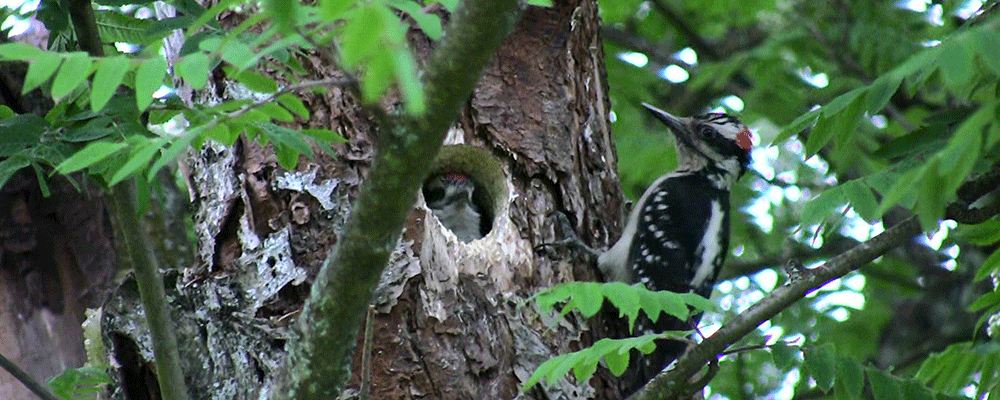Sounds Wild
e-Library Multimedia

Woodpeckers
Drumming up a Mate (mp3)
Audio
Download Episode: Drumming up a Mate (MP3 file 3,841 kB)
Click here to view this episode in separate page.
Flickers (mp3, Transcript)
Audio
Download Episode: Flickers (MP3 file 3,521 kB)
Flicker
The northern flicker is a large woodpecker that's fairly common throughout most of North America. There are two distinct geographical groups which look quite different, red-shafted and yellow-shafted flickers. Until the 1980s, these were considered to be separate species. Yellow shafted flickers are found in the east and the Pacific Northwest, red-shafted flickers are found in the West.
As the name implies, the shaft or quill of the birds' wing and tail feathers are either a bright, salmon-red color or a golden yellow color. In addition, red and yellow shafted flickers have different facial markings.
In Southeast Alaska, both types of flickers are found, and there is considerable intergradation of the two races.
Click here to view this episode in separate page.
Saplicking woodpeckers (mp3, Transcript)
Audio
Download Episode: Saplicking woodpeckers (MP3 file 3,657 kB)
Saplicking woodpeckers
The distinct call of a woodpecker carries through the forest. It's not drilling or pecking, it's calling to its mate. These woodpeckers have a nestful of babies in a cavity in a nearby tree, and the hungry babies are keeping both parents busy. These are sapsuckers, woodpeckers that don't just drill into trees for bugs. Like people tapping trees for sap to make birch or maple syrup, sapsuckers create elaborate networks of sap wells and maintain them to ensure sap production. The sap wells are rows of pencil-eraser-size holes pecked through the bark of trees, and the birds lick the sap that oozes out. They also eat insects that get caught in the sap.
Sapsuckers defend their wells from other sapsuckers, as well as from other birds. Rufous Hummingbirds are known to nest near sap wells, follow sapsuckers in their daily movements, and may even time their migration to coincide with sapsucker migrations so they can feed off the sap wells.
Like other woodpeckers, sapsuckers excavatle a new nest cavity each year, and their "leftover" nest cavities are important to other cavity-nesting birds that aren't equipped to build them. Many species of flycatchers, swallows, falcons, and owls nest in cavities, as do ducks like mergansers, goldeneyes and wood ducks - which is why they like nest boxes. Even some mammals like northern flying squirrels nest in woodpecker-made cavities.
Click here to view this episode in separate page.
Woodpecker Tongue (mp3, Transcript)
Audio
Download Episode: Woodpecker Tongue (MP3 file 3,525 kB)
Woodpecker tongue
Woodpeckers are famous for their wood-chiseling beaks, but they are also equipped with an amazing tongue. Woodpeckers peck into tree bark or the wood of dead trees to get at insects living in the wood. Once the woodpecker has excavated a hole in the wood, they need to get the insect or grub out. They use their remarkable tongues to do this.
Their tongues are long and sensitive, which helps them to probe and detect insects in wood. The back of the tongue is attached to a strong, muscular sheath, connected to complex of long bones called the hyoid. The hyoid wraps around the back of the woodpeckers' skull and over the top, creating a mechanism - like the spring of a retractable tape measure - that enables the woodpecker's tongue to extend several inches beyond the tip of the beak. Some woodpeckers' tongues are essentially as four times as long as their beaks.
The tip of the tongue is sharp and barbed, like a tiny harpoon, and their saliva contains a gluey mucus that helps the tongue act like fly paper. Once that sensitive tongue encounters a grub in the wood, it's impaled and stuck to the tongue, enabling the woodpecker to pull it back out.
Click here to view this episode in separate page.
